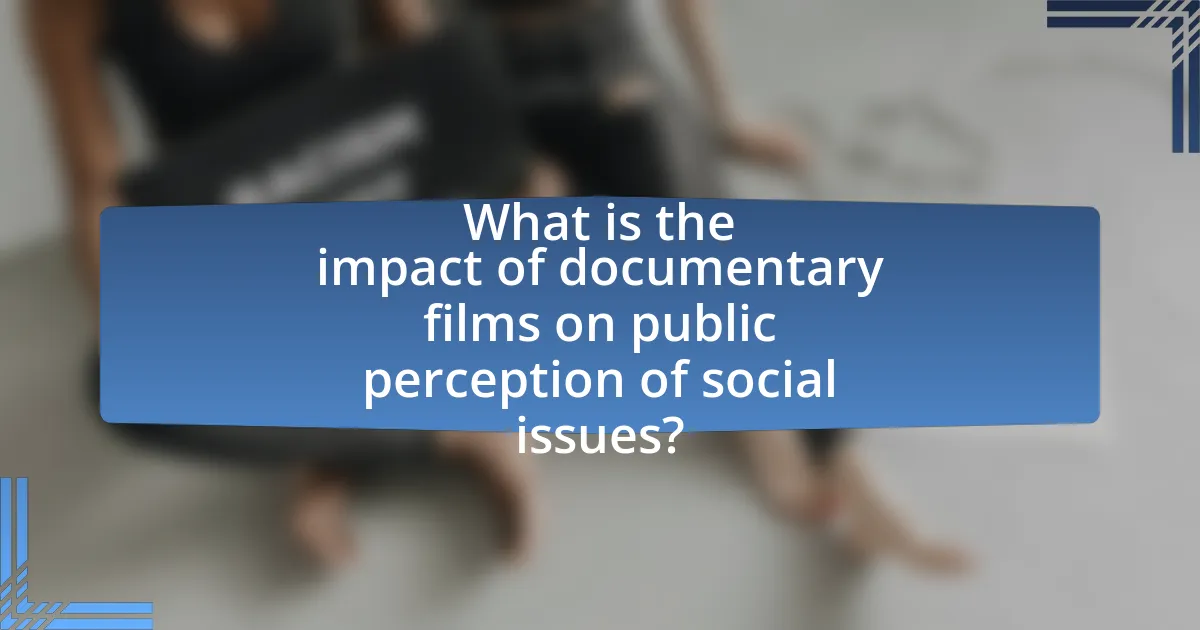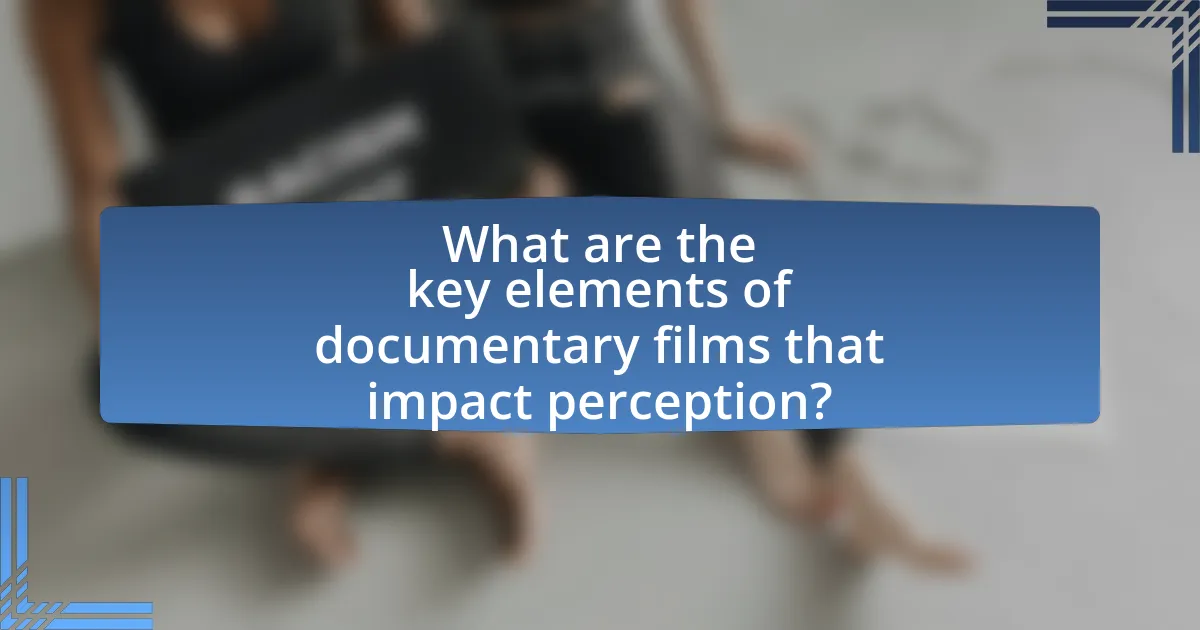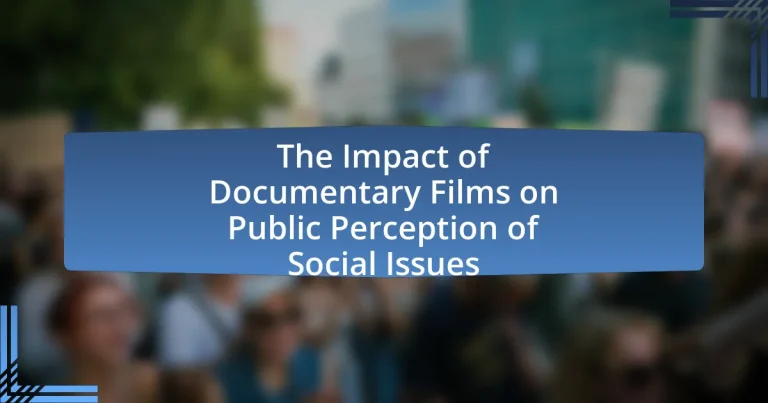Documentary films play a crucial role in shaping public perception of social issues by raising awareness and fostering empathy among viewers. They utilize various techniques, including narrative structure, visual storytelling, and emotional appeal, to influence audience attitudes and behaviors. Research indicates that documentaries can lead to increased engagement with social issues, prompting discussions and activism. By highlighting underrepresented topics and presenting factual narratives, documentaries serve as powerful tools for education and advocacy, ultimately contributing to social change and influencing public discourse on critical issues such as climate change, racial inequality, and human rights.

What is the impact of documentary films on public perception of social issues?
Documentary films significantly shape public perception of social issues by raising awareness and fostering empathy. Research indicates that documentaries can influence viewers’ attitudes and beliefs, often leading to increased engagement with the issues presented. For instance, a study published in the Journal of Communication found that exposure to documentaries about climate change resulted in a greater willingness to support environmental policies among viewers. This demonstrates that documentary films serve as powerful tools for education and advocacy, effectively altering public discourse and prompting social change.
How do documentary films shape societal views?
Documentary films shape societal views by presenting factual narratives that influence public perception and awareness of social issues. These films often highlight underrepresented topics, providing audiences with insights that challenge existing beliefs and stimulate critical thinking. For instance, the documentary “Blackfish” significantly impacted public opinion regarding marine parks and animal rights, leading to increased scrutiny and changes in legislation concerning the treatment of captive orcas. Research indicates that documentaries can evoke emotional responses, which further solidifies their ability to alter viewers’ attitudes and behaviors towards social issues, as evidenced by studies showing increased activism and support for causes featured in such films.
What techniques do filmmakers use to influence audience perception?
Filmmakers use techniques such as narrative structure, visual storytelling, emotional appeal, and sound design to influence audience perception. Narrative structure guides the audience’s understanding and emotional journey, often employing techniques like foreshadowing and pacing to create suspense or empathy. Visual storytelling utilizes cinematography, color grading, and composition to evoke specific feelings and highlight themes, as seen in documentaries like “13th,” which uses stark contrasts to emphasize racial injustice. Emotional appeal is achieved through personal stories and testimonials, making complex social issues relatable, while sound design, including music and ambient sounds, enhances the emotional impact and can manipulate mood, as demonstrated in films like “The Act of Killing,” where haunting scores amplify the gravity of the subject matter. These techniques collectively shape how viewers interpret and engage with the social issues presented in documentary films.
How does storytelling in documentaries affect viewer engagement?
Storytelling in documentaries significantly enhances viewer engagement by creating emotional connections and fostering empathy. When narratives are structured effectively, they draw viewers into the experiences of the subjects, making complex social issues more relatable and understandable. Research indicates that documentaries employing strong storytelling techniques can increase viewer retention and provoke critical thinking, as evidenced by a study published in the Journal of Communication, which found that emotionally charged narratives lead to higher levels of audience involvement and discussion. This engagement is crucial for influencing public perception of social issues, as it encourages viewers to reflect on their own beliefs and consider different perspectives.
Why are documentary films important in raising awareness?
Documentary films are important in raising awareness because they provide factual narratives that illuminate social issues, fostering understanding and empathy among viewers. By presenting real-life stories and evidence, documentaries engage audiences emotionally and intellectually, prompting them to reflect on critical topics such as climate change, human rights, and social justice. For instance, the documentary “An Inconvenient Truth” significantly raised awareness about global warming, leading to increased public discourse and policy discussions. This demonstrates that documentaries can effectively influence public perception and motivate action on pressing social issues.
What role do documentaries play in highlighting underrepresented issues?
Documentaries play a crucial role in highlighting underrepresented issues by providing a platform for marginalized voices and presenting narratives that are often overlooked by mainstream media. They serve as a powerful tool for raising awareness, educating audiences, and fostering empathy through real-life stories and experiences. For instance, documentaries like “13th” by Ava DuVernay expose systemic racism and mass incarceration, prompting public discourse and policy discussions. Additionally, studies show that documentaries can significantly influence viewers’ perceptions and attitudes towards social issues, as evidenced by a 2018 survey published in the Journal of Communication, which found that 70% of viewers reported increased awareness of social justice issues after watching relevant documentaries.
How do documentaries contribute to social change?
Documentaries contribute to social change by raising awareness of critical social issues and influencing public perception. They present factual narratives that highlight injustices, educate viewers, and inspire action, often leading to increased advocacy and policy changes. For instance, the documentary “Blackfish” significantly impacted public opinion regarding marine parks and prompted legislative changes concerning the treatment of captive orcas. Additionally, studies show that documentaries can shift attitudes; a survey indicated that viewers of social issue documentaries are more likely to engage in activism related to the topics presented.

What are the key elements of documentary films that impact perception?
The key elements of documentary films that impact perception include narrative structure, visual aesthetics, sound design, and the use of interviews. Narrative structure guides the viewer’s understanding and emotional engagement, often framing the subject matter in a way that emphasizes specific themes or messages. Visual aesthetics, including cinematography and editing, can evoke emotional responses and shape the viewer’s interpretation of the content. Sound design, including music and ambient sounds, enhances the emotional tone and can influence the viewer’s perception of urgency or importance. The use of interviews provides personal perspectives that can humanize complex issues, making them more relatable and impactful. These elements collectively shape how audiences perceive and understand social issues presented in documentary films.
How does the choice of subject matter influence public perception?
The choice of subject matter significantly influences public perception by shaping the narratives and emotional responses associated with social issues. For instance, documentaries that focus on personal stories and human experiences tend to evoke empathy and a deeper understanding among viewers, leading to increased awareness and advocacy for the issues presented. Research by the University of Southern California found that documentaries addressing social justice issues can alter viewers’ attitudes and increase their likelihood of engaging in activism. This demonstrates that the specific topics chosen in documentary films can effectively frame public discourse and influence societal attitudes towards critical issues.
What types of social issues are commonly addressed in documentaries?
Documentaries commonly address social issues such as poverty, racial inequality, environmental concerns, human rights violations, and health crises. These films often highlight systemic problems and aim to raise awareness among viewers. For instance, documentaries like “13th” explore racial inequality and mass incarceration, while “An Inconvenient Truth” focuses on climate change. Such films utilize statistics and personal stories to illustrate the severity of these issues, thereby influencing public perception and prompting discussions around potential solutions.
How does the portrayal of characters affect audience empathy?
The portrayal of characters significantly affects audience empathy by shaping how viewers connect emotionally with the narrative. When characters are depicted with depth, authenticity, and relatable struggles, audiences are more likely to experience empathy towards them. Research indicates that well-developed characters evoke emotional responses, as seen in studies like “The Role of Character Development in Audience Engagement” by Green and Brock, which found that narratives featuring complex characters lead to higher levels of empathy and engagement. This connection is crucial in documentary films, where the portrayal of real individuals facing social issues can humanize abstract problems, fostering a deeper understanding and emotional investment from the audience.
What is the significance of documentary film festivals and awards?
Documentary film festivals and awards are significant because they provide a platform for showcasing important social issues and fostering public discourse. These events highlight diverse narratives, often bringing underrepresented voices to the forefront, which can influence public perception and awareness of critical topics. For instance, the Sundance Film Festival has been instrumental in launching documentaries that address pressing social issues, such as climate change and human rights, thereby shaping audience understanding and engagement. Additionally, awards like the Academy Awards recognize outstanding documentary work, which can lead to increased visibility and funding for future projects, further amplifying the impact of these films on societal conversations.
How do accolades influence the reach and impact of documentaries?
Accolades significantly enhance the reach and impact of documentaries by increasing visibility and credibility. Winning awards such as the Academy Award or the Sundance Film Festival accolades often leads to greater media attention and distribution opportunities, allowing documentaries to reach wider audiences. For instance, the documentary “13th,” which received multiple awards, gained substantial viewership on Netflix, illustrating how accolades can drive audience engagement and discussions around social issues. Furthermore, research indicates that films recognized by prestigious awards are more likely to be included in educational curricula, thereby influencing public perception and awareness of critical social issues.
What role do festivals play in promoting social issues through film?
Festivals play a crucial role in promoting social issues through film by providing a platform for filmmakers to showcase documentaries that address pressing societal challenges. These events facilitate discussions, raise awareness, and engage audiences in critical dialogues about topics such as climate change, human rights, and social justice. For instance, the Sundance Film Festival has a history of highlighting films that tackle issues like racial inequality and LGBTQ+ rights, thereby influencing public perception and encouraging activism. By attracting diverse audiences and industry professionals, festivals amplify the reach of these films, fostering a greater understanding of social issues and inspiring collective action.

How do audiences respond to documentary films addressing social issues?
Audiences typically respond to documentary films addressing social issues with heightened awareness and emotional engagement. Research indicates that such films can significantly influence viewers’ perceptions and attitudes toward the issues presented. For instance, a study published in the Journal of Communication found that documentaries can evoke empathy and motivate viewers to take action, with 70% of participants reporting increased concern for the social issues depicted after viewing. This emotional response often leads to discussions among viewers, further amplifying the impact of the documentary on public discourse.
What factors affect audience reception of documentary films?
Audience reception of documentary films is influenced by factors such as the film’s narrative structure, emotional appeal, cultural context, and the credibility of the filmmakers. Narrative structure affects how the story is presented, which can engage or alienate viewers; for instance, a compelling storyline can enhance emotional connection. Emotional appeal plays a crucial role, as documentaries that evoke strong feelings tend to resonate more with audiences, leading to greater impact and retention of the message. Cultural context shapes how viewers interpret the content based on their backgrounds and experiences, which can either facilitate understanding or create barriers. Lastly, the credibility of filmmakers, including their expertise and perceived objectivity, significantly affects audience trust and engagement, as seen in studies indicating that viewers are more likely to accept information from filmmakers with established reputations.
How does prior knowledge of a topic influence viewer interpretation?
Prior knowledge of a topic significantly influences viewer interpretation by shaping the lens through which information is processed. When viewers possess background knowledge, they can connect new information to existing frameworks, enhancing comprehension and retention. For instance, research by Kintsch (1998) in “The Construction of Meaning” demonstrates that individuals with prior knowledge are better at integrating new content, leading to deeper understanding and critical analysis. This cognitive engagement allows viewers to discern nuances and biases in documentary films, ultimately affecting their perception of social issues presented.
What emotional responses do documentaries evoke in viewers?
Documentaries evoke a range of emotional responses in viewers, including empathy, anger, sadness, and inspiration. These emotional reactions are often triggered by the portrayal of real-life events and personal stories that resonate with audiences. For instance, studies have shown that documentaries addressing social issues, such as poverty or injustice, can lead to increased empathy and a desire for social change among viewers. Research published in the journal “Media Psychology” indicates that emotionally charged narratives in documentaries can significantly influence viewers’ attitudes and behaviors towards social issues, reinforcing the idea that emotional engagement is a powerful tool for raising awareness and prompting action.
How can documentary films lead to action among viewers?
Documentary films can lead to action among viewers by effectively raising awareness and evoking emotional responses to social issues. These films often present compelling narratives and factual evidence that highlight injustices or urgent problems, prompting viewers to feel a sense of urgency or responsibility. For instance, the documentary “Blackfish” significantly influenced public perception of marine parks and led to increased activism against orca captivity, resulting in policy changes and shifts in consumer behavior. Research indicates that documentaries can enhance empathy and motivate individuals to engage in advocacy or support related causes, as evidenced by a study published in the journal “Media Psychology,” which found that viewers who watched socially relevant documentaries were more likely to participate in related social movements.
What strategies do filmmakers use to encourage activism?
Filmmakers use various strategies to encourage activism, including storytelling, emotional engagement, and providing actionable information. By crafting compelling narratives, filmmakers can evoke empathy and inspire viewers to take action on social issues. For instance, documentaries like “13th” by Ava DuVernay highlight systemic racism and mass incarceration, prompting discussions and movements for criminal justice reform. Additionally, filmmakers often include calls to action at the end of their films, directing audiences to organizations or initiatives where they can contribute or participate. This combination of emotional resonance and practical guidance effectively mobilizes viewers toward activism.
How effective are documentaries in mobilizing public opinion?
Documentaries are highly effective in mobilizing public opinion, as they can evoke emotional responses and raise awareness about social issues. Research indicates that documentaries often lead to increased public engagement and advocacy; for instance, a study published in the Journal of Communication found that viewers of social issue documentaries were more likely to participate in related activism and discussions. Additionally, documentaries like “Blackfish” and “An Inconvenient Truth” have significantly influenced public perceptions and policy changes regarding animal rights and climate change, respectively, demonstrating their power to shape opinions and drive social movements.
What are best practices for creating impactful documentary films?
To create impactful documentary films, filmmakers should focus on thorough research, compelling storytelling, and authentic representation of subjects. Thorough research ensures accuracy and depth, allowing filmmakers to present well-informed narratives that resonate with audiences. Compelling storytelling engages viewers emotionally, often utilizing a clear narrative arc that highlights conflict and resolution, which is essential for maintaining interest. Authentic representation of subjects fosters trust and credibility, as seen in documentaries like “13th” by Ava DuVernay, which effectively addresses systemic racism through personal stories and historical context. These practices collectively enhance the film’s ability to influence public perception of social issues.


